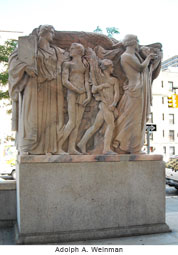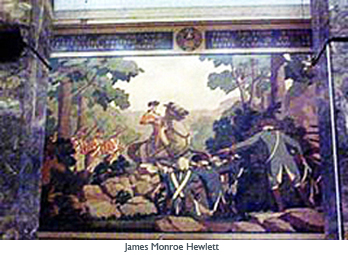The Bronx County
Court Building
|
|
The Bronx County Building is an enormous limestone structure in the Art Moderne style. It was built in 1933 by the architects Joseph Freedlander and Max Hausle in collaboration with the artists Adolph A. Weinman (1870-1952) who designed the rectangular block sculptures at the entrances to the building, and Charles Keck (1875-1951) who designed the friezes. The Art Deco design of the building reflects the architecture of many of the buildings along the Grand Concourse. The project was sponsored by the Works Progress Administration.
The tall rectangular block sculptures by Adolph A. Weinman are largely allegorical, paying homage to the history of government by law through the ages, beginning with Egypt, Greece, and Rome. They were created with the assistance of collaborators George H. Snowden, Joseph Kiselewski, and Edward F. Sanford, among others. The friezes which run along each façade on either side of simple ionic styled columns are by Charles Keck. As with the Weinman sculptures in the round, Keck's friezes also refer to classical, biblical and symbolic themes including the west façade frieze depicting the Civil War surrender of General Lee to General Grant, revolutionary pipers in uniform; images of a young, growing and working America; as well as an allusion to slavery.
Inside the Bronx County Building in the first floor rotunda is the Veteran's Memorial Hall dedicated to the memory of the men of the Bronx who fought in the Spanish-American War and the World War I. The four murals by James Monroe Hewlett (1868-1941), however, illustrate historical moments in the fight for freedom and justice which took place in the Bronx. They were designed in collaboration with Adolph A. Weinman and Charles Keck. The four murals describe: the Settlement of the Territory by Jonas Bronck Under the Dutch; the Establishment of Courts of Justice under the English; The Battle of Pells Point and Defeat of the British; and Reception for George Washington at Van Cortlandt Mansion.
The tall rectangular block sculptures by Adolph A. Weinman are largely allegorical, paying homage to the history of government by law through the ages, beginning with Egypt, Greece, and Rome. They were created with the assistance of collaborators George H. Snowden, Joseph Kiselewski, and Edward F. Sanford, among others. The friezes which run along each façade on either side of simple ionic styled columns are by Charles Keck. As with the Weinman sculptures in the round, Keck's friezes also refer to classical, biblical and symbolic themes including the west façade frieze depicting the Civil War surrender of General Lee to General Grant, revolutionary pipers in uniform; images of a young, growing and working America; as well as an allusion to slavery.
Inside the Bronx County Building in the first floor rotunda is the Veteran's Memorial Hall dedicated to the memory of the men of the Bronx who fought in the Spanish-American War and the World War I. The four murals by James Monroe Hewlett (1868-1941), however, illustrate historical moments in the fight for freedom and justice which took place in the Bronx. They were designed in collaboration with Adolph A. Weinman and Charles Keck. The four murals describe: the Settlement of the Territory by Jonas Bronck Under the Dutch; the Establishment of Courts of Justice under the English; The Battle of Pells Point and Defeat of the British; and Reception for George Washington at Van Cortlandt Mansion.
[More about the artists]
[More about the Grand Concourse]

